While I generally like the overall look of most models I build, some end up looking particularly “tough”. Aggressive. Like it has an attitude. The final result just begs to be flown around the room whilst all manner of engine and machine gun noises are being made. (Never mind that I’m an old man!)
This Corvus Blackstar certainly falls into that category.
While I didn’t impress myself with the overall finish, it just looks mean. The 10 year old in me can imagine it screaming in from above, barely but a blur as it streaks across the battlefield. If there were a soundtrack in the background, I’m quite sure it would be Judas Priest’s “You Got Another Thing Coming”. The camera would pan to a shot of the pilot, grim determination on his face, the stub of a cigar clenched in his teeth. In the crew compartment, the troops are locked and loaded while the team sergeant says “Stand by!”
Cue the external view as the ship screams over the heads of the beleaguered good guys, surrounded by bad guys. The dust and smoke swirl, yet above the din of battle the shrieks of the engines drown all out. As it flares out for a landing, its weapons light up, raining steel down on the oppressing enemy hordes.
Inside, a shot of the doors opening up, the troops holding to handholds as the ship buffets from the violent maneuvers. A light turns green, and the team sergeant shouts “FOLLOW ME!”, and out the door they go…
Yeah…
😀
This is why I build models. It fires the imagination.
Cool… But How About The Model?
Oh, yeah… the model.
It’s great.
If you’ve built any Citadel vehicles, you’ll know what I mean when I say it is a fun, trouble free build. Glue the parts on. Paint them. Weather them. That’s pretty much it.
I built most of the airframe up in its entirety, only leaving off the rotating rocket launches on the lower sides of the hull, and the upper guns and rocket launchers. In retrospect, I probably should have left the various jet nozzles off too, just to make painting easier, but even that wasn’t too egregious a problem.
I primed the model using Badger’s Stynylrez Black Primer. I next went in with some darker grays for a base coat, then tried to build up some subtle shading and highlighting using slightly lighter grays and pure blacks. It all looked kinda cool until I added the final matt coat, which toned everything down, and left the black looking a bit flat. (Note to self: “Subtle” and “40K” don’t work together. 😉 )
The red areas were painted with Vallejo Mecha Color Dark Red, and then lightened up a bit with an overcoat of Ammo of Mig Red acrylic paint. Gold areas were treated to Citadel’s Retributor Armor, a very nice, warm gold color. Leadbelcher, a silver color that leans in overall tone towards the gunmetal side of things, led the show on the silver areas.
I decided to try the Games Workshop style edge highlighting on this one, a decision I ended up regretting. I think drybrushing would have looked better overall, and taken way, way, WAY less time. I’m quite sure there are approximately all the miles of edges on this model.
The edging was done with Vallejo’s Basalt Gray, and Citadel’s Wild Rider Red, Auric Armor Gold, and Runefang Steel. For the paint chipping, I used the sponge method, making use of Vallejo’s Sky Gray for the black areas, and the Wild Rider Red for the red areas. I added a few brush applied paint chips here and there, also. In a few spots I tried to give the appearance of paint chipped down to the primer/composite armor (whatever you prefer!) by using Ammo of Mig Chipping color, but it really didn’t have the effect I wanted, being a bit lost in the final result.
I also added some exhaust stains and oil leaks, though given they were added over such a dark base, when I applied the matt varnish they just faded away. If you look real close in bright light, they show up, but in the photos, or from a distance, it’s gone. Oh well…
I should have used lighter colors.
Still – I’m not one to flog a model to perfection. I generally accept that all of my builds will have some (many!) flaws. I actually have a slight fear that if I ever get one built to the point that I don’t feel there are any flaws, I might stop modeling. What I’d do afterwards, I’m not sure. (Maybe take up the ukulele, or stamp collecting? 😉 )
The base was a bit of an experiment. I wanted a weird Mars-like look, as if it were a red planet with lots of swirly things that swirl on the surface in a swirling fashion. I gave it a coat of Citadel’s Stirland Battlemire, a thick, muddy technical paint. Once it was dry, I added drops of various rust colors from Vallejo, and then stippled it all with a large, soft brush completely soaked in water. It all ran together in a huge mess, and I thought “there’s another experiment gone wrong.” I set it aside to work on other things, and then picked it up a few hours later to try again. It had dried, and actually produced exactly the effect I was looking for. I could almost hear Bob Ross saying “Now there’s a happy accident.”
While the final result is not the best piece of work I’ve ever done, I kind of like it. It was fun. It’s not often I actually fly a model around the ManCave© and make engine and gun noises. But I certainly did with this one!
While I have enjoyed every Citadel Warhammer 40K build I’ve done, this one was just particularly fun. I think that because it’s so over the top visually, so brutish looking, it really fires up the imagination. I’ll say it again – pick up a Warhammer model and just build it. Trust me.
I’m going to fly my model around the room now. With the music turned way up. You have to admit that would be a pretty cool soundtrack for a movie, right? 😉


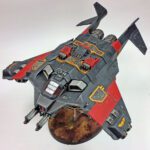
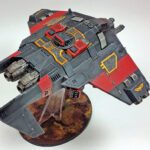
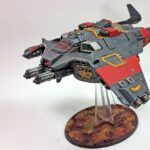
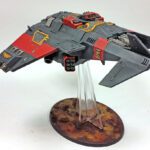
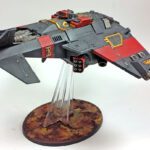
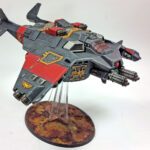
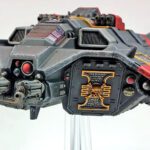

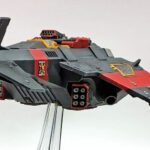

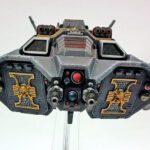
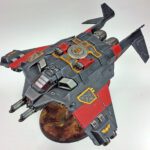
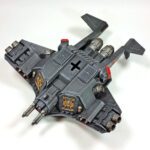
Leave a Reply